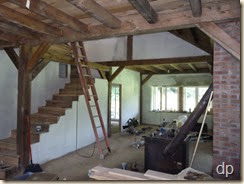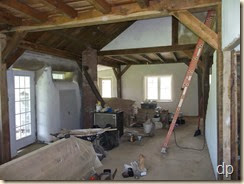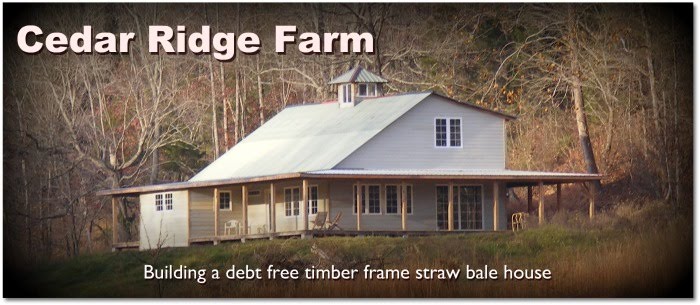Work on the house was delayed during much of the spring and early summer because of other demands upon my time. These were important activities, many of them involving spending time with and being a father to our children. It’s a blessing to have a plethora of things to do.
We have spent time during the last few weeks on plaster and painting.  We still have the upstairs walls to finish plastering and two walls in the pantry. We’ll finish those in the next few weeks. Completing the plastering before the weather turns cool is important – it needs to be warm and dry enough for it to dry properly.
We still have the upstairs walls to finish plastering and two walls in the pantry. We’ll finish those in the next few weeks. Completing the plastering before the weather turns cool is important – it needs to be warm and dry enough for it to dry properly.
We’ve also spent time painting interior walls. This is a one of those things that we want to have completed before we begin to put down the hardwood floors. The paint we’re using is some that I’ve developed a recipe for. There are several different varieties of natural paint. The one we’re using uses wheat paste as the binder.
Using a natural paint is important to me. We have natural, earthen plaster walls, and it would just be wrong to put a synthetic, latex paint on them. One of the benefits of earthen plaster is its ability to “breathe.” It naturally absorbs and releases atmospheric moisture (clay is hydrophilic), 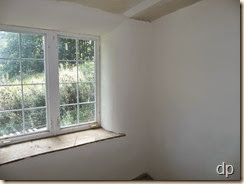 and it also allows moisture in the straw in the walls to pass on through rather than get caught. Moisture in the straw would not be a good idea. With clay-based plaster, moisture that naturally gets inside the wall will be able to get out. Many people don’t realize that moisture within walls is a factor in stick-built houses, too. The inside environment, especially during the winter, is warmer and more humid than outside. Moisture in the air will naturally move toward a less moist environment. It will move through a wall. If it hits a cold, vapor-impermeable skin on the outside, it will condense within the wall. Some wall construction methods may be able to handle this condensed moisture, but straw bale is not one of them.
and it also allows moisture in the straw in the walls to pass on through rather than get caught. Moisture in the straw would not be a good idea. With clay-based plaster, moisture that naturally gets inside the wall will be able to get out. Many people don’t realize that moisture within walls is a factor in stick-built houses, too. The inside environment, especially during the winter, is warmer and more humid than outside. Moisture in the air will naturally move toward a less moist environment. It will move through a wall. If it hits a cold, vapor-impermeable skin on the outside, it will condense within the wall. Some wall construction methods may be able to handle this condensed moisture, but straw bale is not one of them.
So, how does paint affect that? On the outside, it can have a greater effect if it prevents moisture from getting out the cooler side. 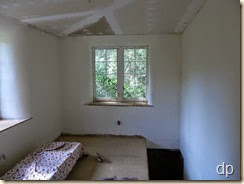 On the inside, it may be less of an issue. The general rule/idea is to have greater vapor-permeability on the outside of the wall than on the inside. So, maybe latex paint would be alright on the inside, but why use it on natural walls? If I go to the trouble of mixing and putting 12 tons of earthen plaster on the inside walls, why would I want to cover them with a plastic coating? It just wouldn’t be right.
On the inside, it may be less of an issue. The general rule/idea is to have greater vapor-permeability on the outside of the wall than on the inside. So, maybe latex paint would be alright on the inside, but why use it on natural walls? If I go to the trouble of mixing and putting 12 tons of earthen plaster on the inside walls, why would I want to cover them with a plastic coating? It just wouldn’t be right.
So, I’m making paint. Sure, it’s not washable, but neither are the walls. If you put enough water on them and scrub, you’re going to take off part of them, and I wouldn’t really like that! You can’t treat these walls like that; they have to be cared for. They aren’t concrete and they aren’t drywall – and I’m happy they aren’t. If you bang something into them, 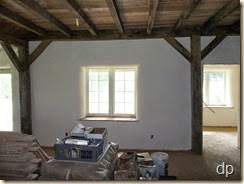 you’ll likely make a divot. They are organic in composition, shape, and function. So, the paint that goes on them must also be.
you’ll likely make a divot. They are organic in composition, shape, and function. So, the paint that goes on them must also be.
Originally, I was going to let the wall color be in the finish coat of plaster. However, that didn’t work. Instead of coming out a nice white, they end up gray when the plaster dries. Maybe there was another way to mix the plaster, different ingredients to use, or something, but I didn’t do it. Because of that, our application involves paint.
It’s been fun developing my own paint recipe. I’m not sure I want to share it, yet. I've thought of maybe selling natural paint in powder form. Just add 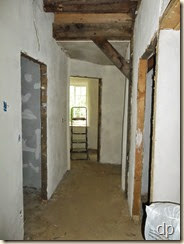 water. The natural paints you can buy online seem to cost an arm and two legs. The paint I’m making doesn’t have to cost that much, and in powdered form, it’s dry, not too heavy to ship, and will keep for a long time. It’s important to use what you mix up, because if you let it sit for a couple of days, the wheat paste will begin to sour, and that’s not really pleasant.
water. The natural paints you can buy online seem to cost an arm and two legs. The paint I’m making doesn’t have to cost that much, and in powdered form, it’s dry, not too heavy to ship, and will keep for a long time. It’s important to use what you mix up, because if you let it sit for a couple of days, the wheat paste will begin to sour, and that’s not really pleasant.
I mix the paint with an electric mixer. I wore out two cheap ones – the plastic gears inside aren’t made to handle a lot of use. Last week I found two heavy duty ones at thrift shops for about $1 each. I put the dry, mixed ingredients in a bowl, add water, and then mix. It get beaten pretty vigorously. If more water is needed, I just add more. It can be mixed to whatever consistency, thick or thin, that I desire.
Anyway, enjoy the photos of the painting we’ve been doing. There’s still quite a bit more to do. It takes a minimum of three coats. The plaster really soaks up the first coat. When it’s fully covered, it really looks nice. I’ve mixed the paint to an off-white color. Originally, it was going to be kind of a light yellow, but I’ve adjusted it to be more white than yellow. It really brightens things up!